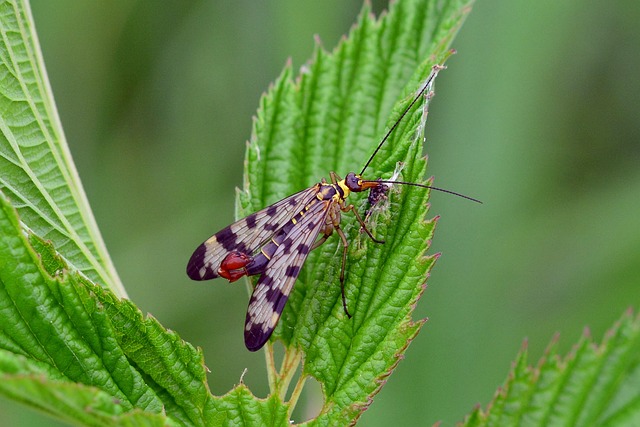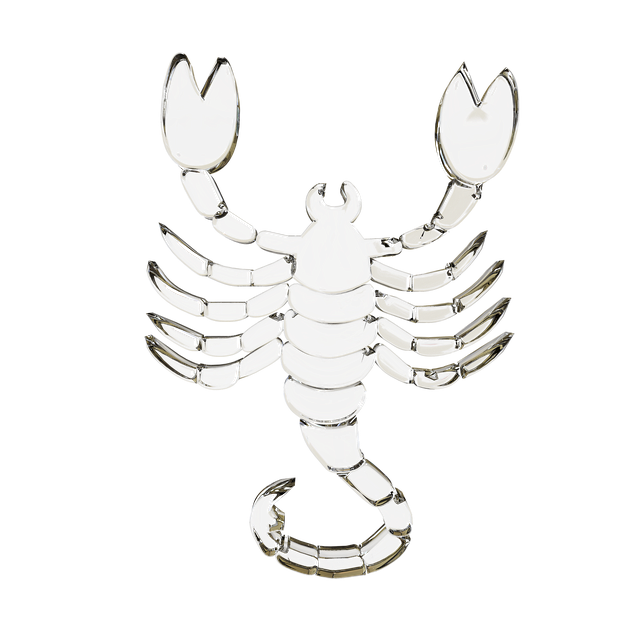In Tucson, Arizona, seasonal changes significantly influence the behavior of local scorpions, particularly the venomous Arizona bark scorpion. As temperatures rise in spring, scorpions become more active, necessitating scorpion control measures to protect homes and residents. During Tucson's hot summer months, their nocturnal activity peaks, making it critical to implement effective pest management practices such as sealing entry points, maintaining landscaping, and applying strategic scorpion control solutions. Autumn sees scorpions retreating to moist areas as temperatures drop, making this an optimal time for population monitoring and control, including the elimination of harborage sites. In winter, while scorpion activity decreases, sustained scorpion control Tucson initiatives are vital to prevent population surges when warmer weather returns. Understanding these seasonal patterns is essential for developing targeted scorpion control strategies that ensure safety and comfort for residents, while also respecting the natural habits of scorpions. Residents should take proactive measures, including sealing entry points and maintaining a dry environment, and seek professional scorpion control Tucson services for effective treatment and management throughout the year to minimize encounters with these creatures.
Exploring the seasonal rhythm of Catalina Foothills’ scorpions unveils a fascinating interplay between these arachnids and their desert habitat. This article delves into the behaviors that dictate their movements, emphasizing the importance of understanding such patterns for effective scorpion control in Tucson. From decoding the dynamics of their seasonal behavior to proactive measures against surges, we’ll cover how environmental factors shape their habitat and activity patterns. Additionally, we’ll explore mitigation strategies for managing these creatures within Tucson homes, ensuring safety and comfort throughout the year.
- Decoding the Dynamics: Seasonal Behavior of Catalina Foothills Scorpions
- Scorpion Control Tucson: Proactive Measures Against Seasonal Surges
- Habitat and Activity Patterns: How Environmental Factors Influence Scorpion Movement
- Mitigation Strategies: Effective Techniques for Seasonal Scorpion Management in Tucson Homes
Decoding the Dynamics: Seasonal Behavior of Catalina Foothills Scorpions

The seasonal activity patterns of Catalina Foothills scorpions in Tucson are a subject of keen interest for both scientists and those seeking effective scorpion control solutions. These arachnids exhibit distinct seasonal behaviors influenced by the region’s climate, vegetation, and human activities. As temperatures rise in the spring, scorpions become more active, often venturing into residential areas in search of prey and ideal microhabitats. Homeowners may notice an increase in sightings during this period, prompting a heightened focus on scorpion control measures to safeguard homes and ensure comfort and safety for occupants. Throughout the hot summer months, scorpions tend to be most active at night when the environment is cooler. This pattern leads to higher encounters with humans, necessitating robust scorpion control strategies that include sealing entry points, proper landscaping maintenance, and the use of appropriate pest management techniques.
Come autumn, scorpions begin to retreat deeper into burrows or under debris, seeking moist hiding spots as the air dries out. This behavior not only aids in conserving moisture but also serves as a defense mechanism against the dropping temperatures and potential predators. During this season, scorpion control efforts shift towards monitoring and managing populations, as well as identifying and eliminating harborage areas. The cooler months of winter bring a decrease in activity, with scorpions becoming less active due to colder conditions. However, they remain present in the environment, and maintenance of scorpion control measures is essential to prevent a sudden surge in population come the next warming season. Understanding these patterns is crucial for implementing effective scorpion control in Tucson, ensuring that interventions are timed appropriately to manage and mitigate any risks associated with these fascinating but sometimes formidable creatures.
Scorpion Control Tucson: Proactive Measures Against Seasonal Surges

In Tucson, Arizona, scorpion control measures are paramount, particularly as the seasons shift and bring about a surge in these arachnids’ activity. The Catalina Foothills, known for its diverse landscapes and residential areas, becomes home to various species of scorpions, with the Arizona bark scorpion being one of the most common and venomous. As temperatures rise during the summer months, these creatures, which are nocturnal and adept at conserving moisture, become more active, seeking out cooler environments often found within human dwellings. Homeowners and residents are advised to adopt proactive measures for scorpion control Tucson to mitigate infestations and protect both their property and personal well-being. This involves maintaining clean and dry living spaces, sealing potential entry points, and keeping outdoor lighting to a minimum, as light can attract insects that scorpions feed upon. Additionally, the use of appropriate containment and removal methods by licensed professionals is crucial when encountering these pests. By implementing such measures, residents can effectively manage seasonal activity patterns of scorpions, ensuring their safety throughout the year in the scenic yet arid Sonoran Desert surroundings. It is through consistent vigilance and proactive strategies that scorpion control Tucson remains a priority for both homeowners and pest management experts alike. Regular inspections and prompt treatment can help keep these creatures at bay, allowing residents to enjoy the region’s beauty without the added worry of an unwelcome scorpion encounter.
Habitat and Activity Patterns: How Environmental Factors Influence Scorpion Movement

The Catalina Foothills, a region near Tucson, Arizona, provides a unique habitat for a variety of scorpion species, with particular attention often given to the infamous Centruroides sculpturator, commonly known for its role in local scorpion control discussions. These arachnids exhibit distinct activity patterns that are closely tied to environmental factors, particularly temperature and humidity. During the hot summer months, when temperatures soar in Tucson and its surroundings, scorpions tend to become more nocturnal, seeking out cooler, darker environments such as under rocks, within shrubbery, and burrows in the soil. This behavior is a direct response to the harsh desert conditions that characterize much of the Catalina Foothills’ landscape. Conversely, as the mercury drops with the onset of autumn, scorpions become more active during the day, preying on insects and other small prey, which are more abundant in the cooler weather. The relative humidity also plays a significant role; higher humidity levels can lead to increased activity, as scorpions require moisture to maintain their cuticles and prevent desiccation.
The interaction between these arthropods and their environment is a testament to the resilience and adaptability of scorpion species in this region. Residents of Tucson and the Catalina Foothills are encouraged to practice effective scorpion control measures, which include habitat modification to reduce their presence in and around dwellings. By understanding the ecological niche of these creatures, local pest management professionals can implement targeted strategies for scorpion control in Tucson, ensuring both the safety of residents and the preservation of these fascinating creatures within their natural environment.
Mitigation Strategies: Effective Techniques for Seasonal Scorpion Management in Tucson Homes

Residents of Tucson are no strangers to the presence of scorpions, particularly during specific seasons when their activity peaks. To effectively manage and mitigate scorpion populations within homes, it’s crucial to implement a combination of proactive and reactive measures. Scorpion control Tucson strategies begin with understanding the habits of these arachnids. Since scorpions seek out moist areas for survival, ensuring that your home is free from harborage sites is paramount. This includes sealing cracks and crevices, particularly around doors, windows, and the foundation. Employing weather stripping and caulking can significantly reduce entry points. Additionally, maintaining a dry environment inside the home by fixing leaks and using dehumidifiers, especially in crawl spaces and basements, can make living areas less hospitable to scorpions.
For residents who have already encountered scorpions within their homes, it’s advisable to contact professional pest control services specializing in scorpion control Tucson. These experts utilize a variety of methods tailored to the specific needs of each home. This may include the application of safe and effective treatments that create a barrier around the perimeter of the dwelling, as well as targeted interior treatments if necessary. Monitoring and maintenance programs are also available to keep scorpion populations under control throughout the year. By combining these approaches with consistent vigilance and awareness, Tucson homeowners can significantly reduce the risk of scorpion encounters and create a more comfortable and safe living environment for themselves and their families.
Residents of the Catalina Foothills region can now approach the seasonal presence of scorpions with greater understanding and effective management strategies. The article has shed light on the intricate seasonal activity patterns of these arachnids, revealing how environmental factors shape their movements and behaviors. By implementing proactive measures as outlined in “Scorpion Control Tucson: Proactive Measures Against Seasonal Surges,” homeowners can minimize encounters with scorpions. The insights provided under “Decoding the Dynamics: Seasonal Behavior of Catalina Foothills Scorpions” and “Habitat and Activity Patterns: How Environmental Factors Influence Scorpion Movement” are crucial for devising robust mitigation strategies, as detailed in “Mitigation Strategies: Effective Techniques for Seasonal Scorpion Management in Tucson Homes.” With this knowledge, the community can coexist with these creatures, ensuring a safer and more comfortable environment throughout the year.
